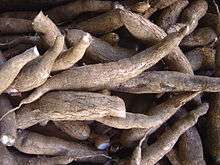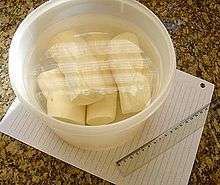Garri
.jpg)


Garri (also known as gari, garry, gali, "cassava flakes" or occasionally[1] tapioca) is a popular West African food made from cassava tubers. The spelling 'garri' is mainly used in Cameroon, Nigeria, Sierra Leone, Benin, Togo and 'gari' in Ghana.[2] In some sub-Saharan regions of Africa, it is referred to as 'gali'.[3]
Process
To make garri, cassava tubers are peeled, washed and grated or crushed to produce a mash. The mash could be mixed with palm oil (oil garri) before being placed in a porous bag. It is then placed in an adjustable press machine for 1–3 hours to remove excess starchy water. When the cassava has become dry enough, it is ready for the next step.[3] It is then sieved and fried in a large clay frying pot with or without palm oil. The resulting dry granular garri can be stored for long periods. It may be pounded or ground to make a fine flour.
Eba is a stiff dough made by soaking gari in hot water and kneading it with a flat wooden baton. Kokoro is a common snack food in Nigeria, especially in southern and southeast Nigeria, especially Abia state, Rivers state, Anambra state, Enugu state and Imo state. It is made from a paste of maize flour, mixed with garri and sugar and deep-fried.[4]
Garri comes in various consistencies, which can roughly be categorized into rough, medium and smooth. Each type is used for a particular food.
As a snack , Cereal, or light meal, garri can be soaked in cold water (in which case it settles to the bottom), mixed with sugar or honey, and sometimes roasted Peanuts or groundnut with/or evaporated milk are sometimes added. The amount of water needed for soaked garri is 3:1. Garri can also be eaten dry without water, but with sugar and roasted peanut added.
In its dry form, garri is used as an accompaniment for soft cooked beans and palm oil. This food mix is called yoo ke garri or Foto gari in the Ga language, in Ghana. Foto gari is the combination of moistened garri and stew, while yoo ke garri is garri with beans, a combination which is typically eaten as lunch.[3] It is also eaten with beans cake in Nigeria.
For a full meal, garri is usually cooked by adding it to hot water, then kneading it into dough. This is eaten with different types of thick, leafy vegetable stews, melon seed stews, peanut stews, or beans.
Smooth garri (known as lebu to the Yoruba) can be mixed with pepper and other spicy ingredients. A small amount of warm water and palm oil is added and mixed with the hand to soften up. This type of garri is served with fried fish. It is also served with frejon on Good Friday.
Variations
In West Africa, there are two types, white and yellow garri. Yellow garri is prepared by frying with the addition of palm oil to give it a yellow colour; white garri is fried without palm oil.
Many variations of yellow and white garri are common across Nigeria. One variation of white garri is popularly known as garri-Ijebu. This is produced mainly by the Yoruba people of Ijebu origin.
In Ghana, garri is judged by its taste and grain size. The sweeter types with finer grains are more valued over sourer, large grain varieties. Commercial food vendors on the other hand prefer coarser grains with high starch content, as this yields more quantity when soaked in water.
Buyers often look out for crispier grains when trying to determine freshness.
Consumption
Garri can be eaten without further cooking, as a snack, by placing it in a bowl and adding cold water; ijebu-garri is made to have finer grains, and a pleasantly sour taste, making it very suitable to be eaten in this way. Sugar or honey is then added as well as chunks of coconut, groundnuts, tigernuts and cashew nuts.
Most garri, however, is cooked by adding it to boiling water and stirring to make a stiff paste or porridge, which among the Igbo people of Nigeria is known as utara, among Yoruba people as eba, or Teba in Northern Nigeria. Utara (or eba) is normally eaten with soups, of which several different kinds are available. Most parts of Africa where cassava is grown have an equivalent staple dish. In most areas of west Africa, garri is usually eaten with water, sugar and groundnuts.
In Liberia, Garri is used to make a dessert called Kanyan which is combined with peanuts and honey.
See also
- African cuisine
- Similar cassava-based dishes
- Poi
- List of African dishes
- Tapai or Peuyeum
- Similar (Kpo Kpo Garri)
References
External links
| Wikimedia Commons has media related to Garri (West Africa). |
- Gari on Ghanaweb.com
- Gari Foto recipe and Gari production on Celtnet Recipes
- Ghanaian recipes and online grocery shopping
- Garri People Forum
- Manufacturer of Garri, Malaysia
- Igbo guide on garri
- Kanyan made from Garri